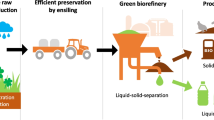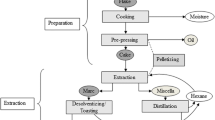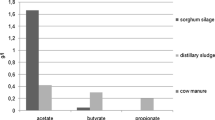Abstract
Increasingly frequent droughts are causing repeated shortages of forage and are creating imbalances in the livestock economy in many parts of the world. More and more rapeseed is being cultivated for biodiesel production, and its straw has to be removed from fields to minimize disease vectors. Despite good drought resistance, rapeseed straw cannot replace forage because of its poor palatability. Our work objective was to design a pilot plant that would be the first of its kind to turn rapeseed straw into artificial forage on a commercial scale and would enable a first techno-economical assessment. Rapeseed straw is intracellularly disintegrated (by steam explosion technology which uses waste heat from a biogas station to minimize the energy demands) and subsequently enzymatically hydrolysed. A series of in vitro and in vivo analyses of nutrition quality were accompanied by a cost breakdown. The findings obtained in pilot scale dimensions revealed for the first time that rapeseed straw can be turned into artificial forage that has, according to the world standard forage price indicator, a relative feed value rated at the same level as alfalfa hay. However, despite energy savings, the cost of processing makes the cost of the artificial forage about 61% higher than conventional forage of the same quality. On the other hand, the potential for further reduction of production costs has been identified. It can be assumed that the price competitiveness can be achieved during extended periods of drought.
Graphical abstract

Similar content being viewed by others
Abbreviations
- RFV:
-
Relative feed value (Moore and Undersander 2002)
- VS:
-
Volatile solids (Shirato and Yokozawa 2006)
- LPC:
-
Labile pools of carbon (Shirato and Yokozawa 2006)
- RPC:
-
Resistant pools of carbon (Shirato and Yokozawa 2006)
- ADL:
-
Acid detergent lignin (Shrivastava et al. 2014)
- NDF:
-
Neutral detergent fibre (Shrivastava et al. 2014)
- P/P 0 :
-
Single point surface area (Maroušek et al. 2015)
- BET:
-
Brunauer–Emmett–Teller surface area (Mardoyan and Braun 2015)
- LSA:
-
Langmuir surface area (Mardoyan and Braun 2015)
- MPA:
-
Micropore area (Mardoyan and Braun 2015)
- ESA:
-
External surface area (Mardoyan and Braun 2015)
- ΣI :
-
Sum of inhibitors (Maroušek et al. 2015)
- ADG:
-
Average daily gain (Shrivastava et al. 2014)
- CP:
-
Crude protein (Shrivastava et al. 2014)
- EE:
-
Ether extract (Shrivastava et al. 2014)
- PCV:
-
Packed cell volume (Shrivastava et al. 2014)
- HM:
-
Haemoglobin (Shrivastava et al. 2014)
- TP:
-
Total protein (Shrivastava et al. 2014)
- AL:
-
Albumin (Shrivastava et al. 2014)
- CR:
-
Creatinine (Shrivastava et al. 2014)
- BUN:
-
Blood urea nitrogen (Shrivastava et al. 2014)
- CH:
-
Cholesterol (Shrivastava et al. 2014)
- NDICP:
-
Neutral detergent insoluble protein (Shrivastava et al. 2014)
- ADIP:
-
Acid detergent insoluble protein (Shrivastava et al. 2014)
- NDFD:
-
Neutral detergent fibre digestibility (Shrivastava et al. 2014)
References
Archer JA, Richardson EC, Herd RM, Arthur PF (1999) Potential for selection to improve efficiency of feed use in beef cattle: a review. Aust J Agric Res 50(2):147–162
Arigbede OM, Tan ZL, Anele UY, Sun ZH, Tang SX, Han XF, Zeng B (2012) Effects of age and species on agronomic performance, chemical composition and in vitro gas production of some tropical multi-purpose tree species. J Agric Sci 150(6):725–737
Castro E, Díaz MJ, Cara C, Ruiz E, Romero I, Moya M (2011) Dilute acid pretreatment of rapeseed straw for fermentable sugar generation. Biores Technol 102(2):1270–1276
Díaz MJ, Cara C, Ruiz E, Romero I, Moya M, Castro E (2010) Hydrothermal pre-treatment of rapeseed straw. Biores Technol 101(7):2428–2435
Hasanuzzaman M, Fujita M (2011) Selenium pretreatment upregulates the antioxidant defense and methylglyoxal detoxification system and confers enhanced tolerance to drought stress in rapeseed seedlings. Biol Trace Elem Res 143(3):1758–1776
Hašková S (2017) Holistic assessment and ethical disputation on a new trend in solid biofuels. Sci Eng Ethics 23(2):509–519
Jeong TS, Um BH, Kim JS, Oh KK (2010) Optimizing dilute-acid pretreatment of rapeseed straw for extraction of hemicellulose. Appl Biochem Biotechnol 161(1–8):22–33
Kang KE, Jeong GT, Sunwoo C, Park DH (2012) Pretreatment of rapeseed straw by soaking in aqueous ammonia. Bioprocess Biosyst Eng 35(1–2):77–84
Karagöz P, Rocha IV, Özkan M, Angelidaki I (2012) Alkaline peroxide pretreatment of rapeseed straw for enhancing bioethanol production by same vessel saccharification and co-fermentation. Biores Technol 104:349–357
Karaosmanoglu F, Tetik E, Gurboy B, Sanli I (1999) Characterization of the straw stalk of the rapeseed plant as a biomass energy source. Energy Sources 21(9):801–810
Kholif AE, Khattab HM, El-Shewy AA, Salem AZM, Kholif AM, El-Sayed MM, Mariezcurrena MD (2014) Nutrient digestibility, ruminal fermentation activities, serum parameters and milk production and composition of lactating goats fed diets containing rice straw treated with Pleurotus ostreatus. Asian Aust J Animal Sci 27(3):357
Lu X, Zhang Y, Angelidaki I (2009) Optimization of H2SO4-catalyzed hydrothermal pretreatment of rapeseed straw for bioconversion to ethanol: focusing on pretreatment at high solids content. Biores Technol 100(12):3048–3053
Mardoyan A, Braun P (2015) Analysis of Czech subsidies for solid biofuels. Int J Green Energy 12(4):405–408
Maroušek J (2014) Novel technique to enhance the disintegration effect of the pressure waves on oilseeds. Ind Crops Prod 53:1–5
Maroušek J, Itoh S, Higa O, Kondo Y, Ueno M, Suwa R, Kawamitsu Y (2012) The use of underwater high-voltage discharges to improve the efficiency of Jatropha curcas L. biodiesel production. Biotechnol Appl Biochem 59(6):451–456
Maroušek J, Itoh S, Higa O, Kondo Y, Ueno M, Suwa R, Kawamitsu Y (2013a) Enzymatic hydrolysis enhanced by pressure shockwaves opening new possibilities in Jatropha Curcas L. processing. J Chem Technol Biotechnol 88(9):1650–1653
Maroušek J, Itoh S, Higa O, Kondo Y, Ueno M, Suwa R, Kawamitsu Y (2013b) Pressure shockwaves to enhance oil extraction from Jatropha Curcas L. Biotechnol Biotechnol Equip 27(2):3654–3658
Maroušek J, Myšková K, Žák J (2015) Managing environmental innovation: case study on biorefinery concept. Revista Técnica de la Facultad de Ingeniería Universidad del Zulia 38(3):216–220
Maroušek J, Kolář L, Vochozka M, Stehel V, Maroušková A (2018) Biochar reduces nitrate level in red beet. Environ Sci Pollut Res 25(18):18200–18203
Mohammadi PP, Moieni A, Komatsu S (2012) Comparative proteome analysis of drought-sensitive and drought-tolerant rapeseed roots and their hybrid F1 line under drought stress. Amino Acids 43(5):2137–2152
Moore JE, Undersander DJ (2002) Relative forage quality: an alternative to relative feed value and quality index. In Proceedings 13th annual Florida ruminant nutrition symposium, vol 32. pp 16–29
Mousavi SMM, Hosseini SZ, Resalati H, Mahdavi S, Garmaroody ER (2013) Papermaking potential of rapeseed straw, a new agricultural-based fiber source. J Clean Prod 52:420–424
Nabarlatz D, Farriol X, Montane D (2004) Kinetic modeling of the autohydrolysis of lignocellulosic biomass for the production of hemicellulose-derived oligosaccharides. Ind Eng Chem Res 43(15):4124–4131
Richards RA, Thurling N (1978) Variation between and within species of rapeseed (Brassica campestris and B. napus) in response to drought stress. I. Sensitivity at different stages of development. Aust J Agric Res 29(3):469–477
Ruosteenoja K, Markkanen T, Venäläinen A, Räisänen P, Peltola H (2018) Seasonal soil moisture and drought occurrence in Europe in CMIP5 projections for the 21st century. Clim Dyn 50(3–4):1177–1192
Schmid A (2010) MTBE degradation by hydrodynamic induced cavitation. Water Sci Technol 61(10):2591–2594
Sharma RK, Arora DS (2015) Fungal degradation of lignocellulosic residues: an aspect of improved nutritive quality. Crit Rev Microbiol 41(1):52–60
Shirato Y, Yokozawa M (2006) Acid hydrolysis to partition plant material into decomposable and resistant fractions for use in the Rothamsted carbon model. Soil Biol Biochem 38(4):812–816
Shrivastava B, Jain KK, Kalra A, Kuhad RC (2014) Bioprocessing of wheat straw into nutritionally rich and digested cattle feed. Sci Rep 4:6360
Svärd A, Brännvall E, Edlund U (2015) Rapeseed straw as a renewable source of hemicelluloses: extraction, characterization and film formation. Carbohydr Polym 133:179–186
Tofanica BM, Cappelletto E, Gavrilescu D, Mueller K (2011) Properties of rapeseed (Brassica napus) stalks fibers. J Nat Fibers 8(4):241–262
Wang ML, Zhao Y, Chen F, Yin XC (2004) Inheritance and potentials of a mutated dwarfing gene ndf1 in Brassica napus. Plant Breed 123(5):449–453
Wi SG, Chung BY, Lee YG, Yang DJ, Bae HJ (2011) Enhanced enzymatic hydrolysis of rapeseed straw by popping pretreatment for bioethanol production. Biores Technol 102(10):5788–5793
Zadrazil F, Kamra DN, Isikhuemhen OS, Schuchardt F, Flachowsky G (1996) Bioconversion of lignocellulose into ruminant feed with white rot fungi—review of work done at the FAL, Braunschweig. J Appl Animal Res 10(2):105–124
Author information
Authors and Affiliations
Corresponding author
Additional information
Publisher's Note
Springer Nature remains neutral with regard to jurisdictional claims in published maps and institutional affiliations.
Rights and permissions
About this article
Cite this article
Škapa, S., Vochozka, M. Waste energy recovery improves price competitiveness of artificial forage from rapeseed straw. Clean Techn Environ Policy 21, 1165–1171 (2019). https://doi.org/10.1007/s10098-019-01697-x
Received:
Accepted:
Published:
Issue Date:
DOI: https://doi.org/10.1007/s10098-019-01697-x




